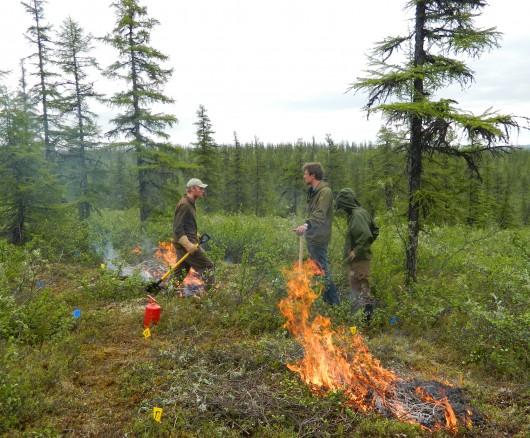I have found myself with the terrestrial crew, which was no surprise, but more specifically with the experimental burn crew, and that has been exciting. So far we have had five full days of work at the Station, and we have been able to accomplish a lot in that time. We have set up sixteen 2×2 meter plots out in the forest by the station. They are designated so that 4 plots are controls (no burn), 4 are light burn, 4 are moderate burn, and 4 are severe burn. These different levels of burn severity should consume the organic layer of the soil to different degrees. This has all sorts of interesting impacts for larch germination and growth. In addition, the amount of carbon and nitrogen available in the soil changes. But what is most interesting to me is what the microbial community is up to after these burns. Many of the soil microbes will die because of the heat from the fire, but those that survive have potentially great conditions to grow in. Fire, depending on the severity, can increase or decrease the amounts of labile carbon (easily digestible), refractory carbon (not easily digestible), nitrogen, and moisture in the soil. To find out how these fire treatments are affecting the microbial community we will be taking soil cores immediately after the fire and about one week after the fire. From these cores we will measure in both the remaining organic layer and the mineral layer; dissolved organic carbon, total soil organic matter, soil moisture, the molecular weight of dissolved organic carbon (lighter is usually more labile carbon), the phenolic content of dissolved organic carbon, soil pH, total dissolved nitrogen, ammonium, nitrate, carbon lability from biological loss of dissolved organic carbon, and lastly enzyme activities. This is a long wordy list, but it should paint a good picture.

I should elaborate on what enzyme activities are. When microbes are limited by a resource that they need, whether it is carbon, nitrogen, or phosphorous, and there is low supply of easily available resources, they produce extra cellular enzymes. It takes a lot of energy to produce these enzymes and once they are out in the environment the microbes have no control over them. Nitrogen acquiring enzymes (e.g. luecine aminopeptidase) break peptide bonds to release smaller, easier-to-use forms of nitrogen. Phosphate acquiring enzymes (phosphatase) cleave phosphate groups off of larger molecules. Carbon acquiring enzymes fall into several groups. Some, such as phenol oxidase,, break down more refractory lignin-like carbon into usable pieces. Others, such as beta-glucosidase, break down more labile carbon like cellulose. Measuring the activities of these enzymes can thus give us a direct measure of what the microbial community is up to and give us an idea of what kinds of carbon pools there are in the soil. At the end of this trip we should have a good idea of how microbial communities respond after different severities of fire, and how deep in the soil profile these effects penetrate. This is interesting particularly in the context of climate change, because both the frequency and severity of fires is expected to increase. In addition, knowledge of microbial communities after wildfires in the Arctic is scarce. The region we are studying in Siberia is even more interesting due to its large carbon stocks in the soil. So basically I am really excited to get started on my project.
In these first five days we have managed to collect almost 1,000 lbs of twigs, branches, and logs. Then we dried all of them. Then we weighed all of them. Then we discovered that hordes of mosquitoes and black flies had been breeding and spawning in our fuel piles. Then we prepared our plots, which included clearing all of the plants on and around them, fluffing the moss so it dries, and taking pre-burn measurements. Finally, today, we burned. This huge amount of man labor culminated in one morning of intense fires and lots of fun. Our timing was perfect, because this afternoon it rained and now our hillside is an ashy-soupy-buggy mess. Tomorrow I sample.




Comment(1)-
Marjorie Pitz says
July 12, 2012 at 5:33 pmLudda– It is great to learn what you are up to. I’m so glad you are excited by your work, and eager to collect data and learn the results. Much of your terminology and science sailed over my head, but I get the gist, and understand “ashy-soupy-buggy mess” just fine. I’m sure you loved the fire part!